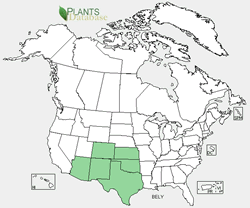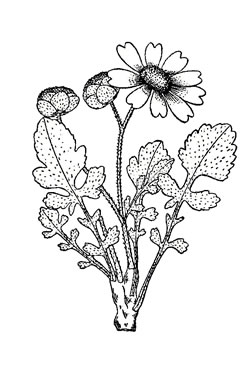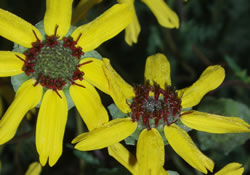Plant of the Week
 Range map of Berlandiera lyrata. States are colored green where the species may be found.
Range map of Berlandiera lyrata. States are colored green where the species may be found.
 This line drawing shows the leaf shape that gives lyreleaf greeneyes its common name. Source: Britton, N.L., and A. Brown. 1913. Illustrated flora of the northern states and Canada. Vol. 3: 464 & USDA-NRCS PLANTS Database.
This line drawing shows the leaf shape that gives lyreleaf greeneyes its common name. Source: Britton, N.L., and A. Brown. 1913. Illustrated flora of the northern states and Canada. Vol. 3: 464 & USDA-NRCS PLANTS Database.
 Lyreleaf greeneyes. Photo by Charlie McDonald.
Lyreleaf greeneyes. Photo by Charlie McDonald.
 Close-up of lyreleaf greeneyes showing the strap-shaped stigmas protruding from the base of the female ray flowers and the anthers protruding from the burgundy-colored male disk flowers. Photo by Charlie McDonald.
Close-up of lyreleaf greeneyes showing the strap-shaped stigmas protruding from the base of the female ray flowers and the anthers protruding from the burgundy-colored male disk flowers. Photo by Charlie McDonald.
Lyreleaf Greeneyes (Berlandiera lyrata)
By Charlie McDonald
Lyreleaf greeneyes is in the small genus Berlandiera, which consists of six species of perennial herbs native to the southern and southwestern United States and Mexico. Lyreleaf greeneyes thrives in sunny places with well-drained disturbed soils so it is often seen along roadsides and in vacant lots.
Chocolate flower is another common name for this plant because the sweetly fragrant blossoms really do smell like chocolate! It is drought tolerant, low maintenance, and adapts to a variety of soils so it has become a favorite in southwestern xeriscape gardening. It readily reseeds itself, making it a desirable addition to wildflower meadows or informal garden areas. The ray petals roll up lengthwise in the heat of the day so it displays itself best in the early morning.
For those interested in the details of plant structure, the flower heads of lyreleaf greeneyes are different from those of most other similar members of the sunflower family. When members of the sunflower family have both ray flowers and central disk flowers, the disk flowers usually produce the seeds and the ray flowers are often sterile; they help attract pollinators with their bright colors, but produce no seeds. It is just the opposite in lyreleaf greeneyes. The ray flowers are female and produce seeds, while the disk flowers are male and produce only pollen. Thus, a flower head of lyreleaf greeneyes that has eight rays produces eight seeds, each of these dispersed as a unit attached to two subtending bracts.

